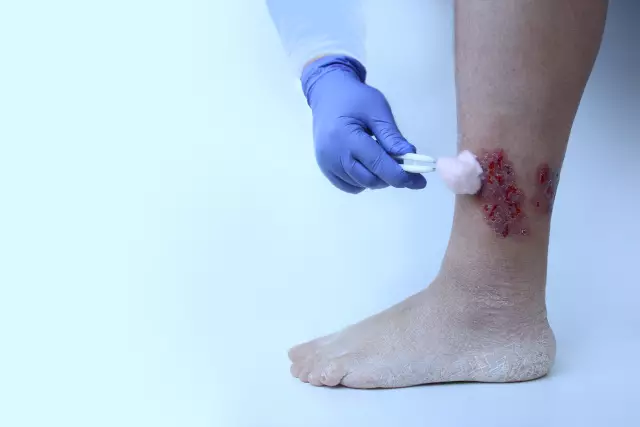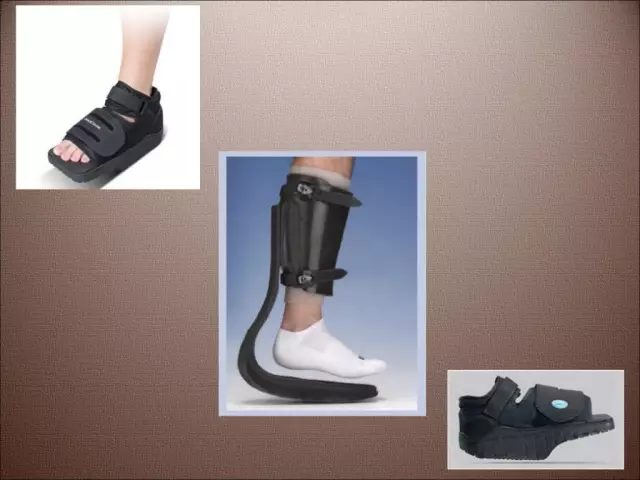- Author Rachel Wainwright [email protected].
- Public 2023-12-15 07:39.
- Last modified 2025-11-02 20:14.
Trophic ulcer

A trophic ulcer is not an independent disease, but a complication of chronic venous insufficiency. It is a defect in the skin or mucous membrane that develops due to the destruction of surface tissues. The tissue is destroyed due to a change in blood flow in the microvasculature and a violation of the innervation at the site of the ulcer. The disease is aggravated by infection and continuing pathological processes in the vascular bed.
Trophic ulcers on the legs are characterized by recurrent long-term treatment, poor healing, violation of many aspects of the quality of life of the sick, and often lead to disability.
Causes of trophic ulcers
Most often, trophic ulcers develop due to:
- Chronic diseases of the veins in the lower extremities - varicose veins, thrombophlebitis with its consequences;
- Obliterating atherosclerosis of the arteries of the lower extremities of various sizes;
- Anatomical and inflammatory diseases of the lymphatic vessels - acute and chronic lymphostasis;
- Diabetes mellitus and its complications;
- Thermal injuries - burns or frostbite;
- Chronic dermatitis, including allergic;
- Injuries to the nerve trunks with a further violation of their integrity;
- Autoimmune diseases of connective tissue, which are accompanied by a systemic disturbance of blood flow in the venous, arterial and microcirculatory bed.
Symptoms of trophic ulcers on the legs
At the very beginning, the skin on the lower third of the lower leg (on the front-inner surface) begins to thin, becomes tense, dry and acquires a mirror-like shine. Characteristic age spots appear on such skin, then a small sore appears, which gradually increases over time. The edges of the ulcer become dense, the bottom of the ulcer bleeds and becomes covered with a bloom of a dirty color. In this condition, any small trauma contributes to the connection of infection and the expansion of the ulcer.
The main complaint with trophic ulcers on the legs is pain. Because of the ulcer, it is difficult for the patient to choose the right shoes and maintain personal hygiene.
Diagnostics
When detecting trophic ulcers on the legs, the main task of the doctor is to determine the cause of the disease. For this, X-ray contrast phlebography, Doppler ultrasonography of the vessels of the lower extremities, percutaneous measurement of the oxygen level and other studies of blood flow in the lower extremities are performed.
From laboratory tests, clinical analyzes of urine and blood, immunological and biochemical studies, bacteriological studies of the discharge from the ulcer for the selection of antibacterial treatment are prescribed.
Complications during trophic ulcer
A progressive ulcer will inevitably cause an increase in the depth and area of the skin defect, and getting inside the infection will provoke the development of lymphangitis, erysipelas, septic complications and lymphadenitis. The ingress of anaerobic flora into the ulcer and tissue necrosis cause gas gangrene, which requires urgent surgical treatment. Sometimes, especially if aggressive drugs (salicylic acid, birch tar, and others) were used to treat a long-lasting ulcer, skin cancer can develop.
Treatment of trophic ulcers
Treatment of trophic ulcers of the lower extremities should be comprehensive and aimed at both local manifestations of pathology and the elimination of the disease that led to the necrotic defect.
Most often, for the treatment of trophic ulcers of the lower extremities, the ulcer is closed using conservative measures, and then surgery is performed on the venous system. Treatment can be carried out both in a hospital and at home, depending on the patient's condition. As a topical treatment, the ulcer is cleaned every day with a sponge or wipes soaked in an antiseptic solution, a bandage with a healing ointment is applied and an elastic bandage is worn. After the ulcer has healed, the remaining scar must be protected from any possible trauma.

Ointment recipe for the treatment of trophic ulcers of the lower extremities: it is necessary to pour one tablespoon of fresh sunflower oil (unrefined, preferably rustic) into an enamel mug. The oil is boiled in a water bath for twenty minutes. Next, add one tablespoon of pharmaceutical fish oil to it and boil in a water bath for another twenty minutes. Then you need to take twenty-five streptocide tablets, grind them and pass through a sieve. The resulting powder is poured into a mug with oil and fish oil and the whole thing is boiled for thirty minutes. The resulting ointment should be applied to trophic ulcers and bandaged. The dressing needs to be changed every day. Two weeks of using such an ointment will help get rid of a trophic ulcer.
YouTube video related to the article:
The information is generalized and provided for informational purposes only. At the first sign of illness, see your doctor. Self-medication is hazardous to health!






